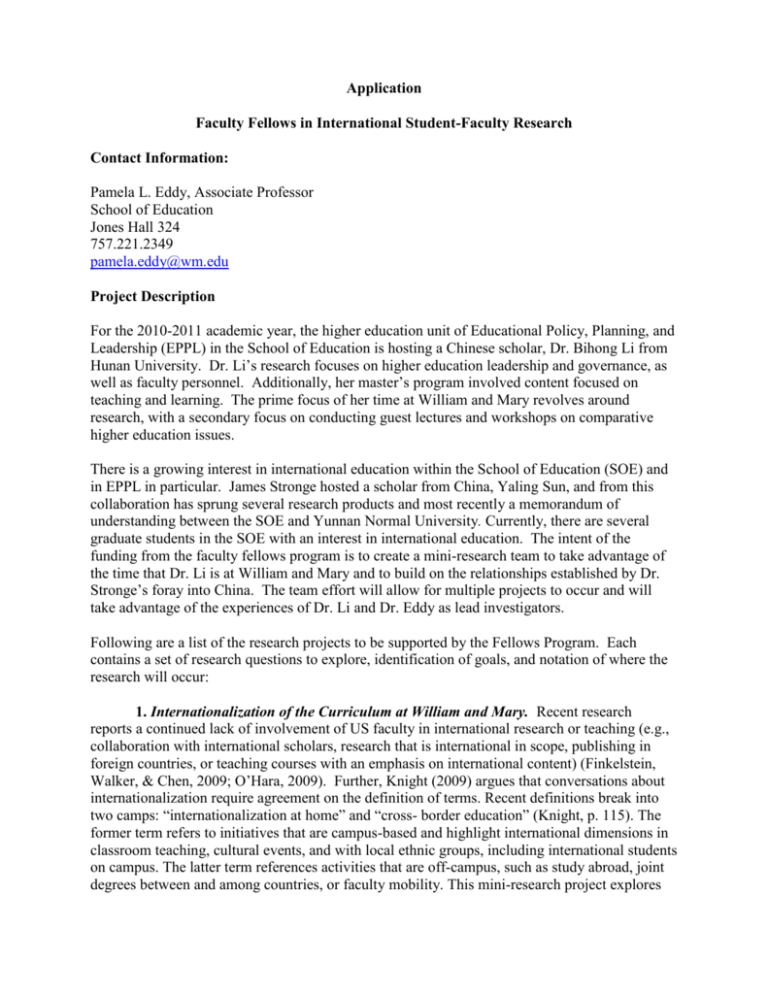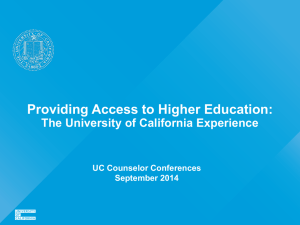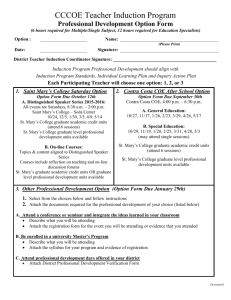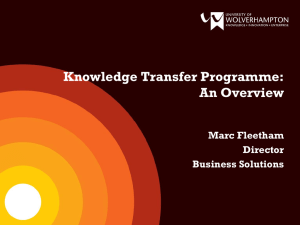Application
advertisement

Application Faculty Fellows in International Student-Faculty Research Contact Information: Pamela L. Eddy, Associate Professor School of Education Jones Hall 324 757.221.2349 pamela.eddy@wm.edu Project Description For the 2010-2011 academic year, the higher education unit of Educational Policy, Planning, and Leadership (EPPL) in the School of Education is hosting a Chinese scholar, Dr. Bihong Li from Hunan University. Dr. Li’s research focuses on higher education leadership and governance, as well as faculty personnel. Additionally, her master’s program involved content focused on teaching and learning. The prime focus of her time at William and Mary revolves around research, with a secondary focus on conducting guest lectures and workshops on comparative higher education issues. There is a growing interest in international education within the School of Education (SOE) and in EPPL in particular. James Stronge hosted a scholar from China, Yaling Sun, and from this collaboration has sprung several research products and most recently a memorandum of understanding between the SOE and Yunnan Normal University. Currently, there are several graduate students in the SOE with an interest in international education. The intent of the funding from the faculty fellows program is to create a mini-research team to take advantage of the time that Dr. Li is at William and Mary and to build on the relationships established by Dr. Stronge’s foray into China. The team effort will allow for multiple projects to occur and will take advantage of the experiences of Dr. Li and Dr. Eddy as lead investigators. Following are a list of the research projects to be supported by the Fellows Program. Each contains a set of research questions to explore, identification of goals, and notation of where the research will occur: 1. Internationalization of the Curriculum at William and Mary. Recent research reports a continued lack of involvement of US faculty in international research or teaching (e.g., collaboration with international scholars, research that is international in scope, publishing in foreign countries, or teaching courses with an emphasis on international content) (Finkelstein, Walker, & Chen, 2009; O’Hara, 2009). Further, Knight (2009) argues that conversations about internationalization require agreement on the definition of terms. Recent definitions break into two camps: “internationalization at home” and “cross- border education” (Knight, p. 115). The former term refers to initiatives that are campus-based and highlight international dimensions in classroom teaching, cultural events, and with local ethnic groups, including international students on campus. The latter term references activities that are off-campus, such as study abroad, joint degrees between and among countries, or faculty mobility. This mini-research project explores both domains of internationalization. The 2009 William and Mary faculty survey found that 66% of faculty claim to use their research to address national or international issues. The inclusion of “national” issues in the survey question, however, clouds the measure of efforts focused on international issues. Further, exploration of international issues per se is markedly different than doing research that is international in scope. More to the point, the William and Mary faculty survey found that 41% engaged in research that focused on international/global issues. This percentage is above the national averages found in the UCLA HERI data shows that highlights only 28% of public university faculty and35% of private university faculty focused on international/global issues. What remains unknown is how William and Mary faculty were defining their research regarding international/global issues. For example, on the one hand, an international issue is the role of sustainability. On the other hand, looking at resource depletion issues and sustainability in sub-Saharan Africa pertains more directly to an international research project. The research questions include in this mini-research section include: How do William and Mary faculty define and internationalize educational efforts at home? How do faculty and student experiences abroad impact global competency? Part I of this research project involves conducting a survey to determine the extent to which curriculum is internationalized and to define what various faculty mean when they say “internationalism.” How do faculty members define their international research and what current projects are underway? Part II of this research includes a qualitative phenomenology to understand from a teaching perspective what it means for faculty to teach abroad—participants will include those faculty members who have led global study abroad trips as well as those that have taught abroad using sabbatical leaves or Fulbright scholarships. Visiting scholars at William and Mary who are teaching and doing research at the university for the year will also be included to obtain an appreciation of their experiences in the US teaching environment. Faculty Expertise: Dr. Eddy and Dr. Li have both conducted research regarding faculty work. Dr. Eddy completed a Fulbright Scholarship in Ireland in 2009 and conducted a research project there on the experiences of Fulbright scholars teaching abroad. Student Involvement: Graduate students in the SOE will be part of the research team and will be treated as co-researchers in the project. Undergraduate student involvement will be sought through listserv announcements and faculty networking, particularly with students interested in teaching and learning research and research regarding faculty work. A broad range of undergraduate programs will be contacted that may have students interested in these areas of inquiry. Students will help with the project design, will conduct interviews, transcribe interviews, and help on the team analysis of the data. The Asian Student Council (ASC) and the Chinese Student Organization (CSO) in particular will be targeted for undergraduate student researchers. Students with a special interest in an aspect of the project may opt to pursue an individual line of inquiry as well, and co-publish and co-present on the research findings (see “Outcomes” below). Outcomes: Several outcomes will occur from this multistage research project. First, students will obtain experience in data collection and analysis that will be immediately relevant to the advancement of their skills in research. Second, the research will result in a monograph for internal use and will be presented at a campus brown bag workshop. Finally, proposals will be created for the two main higher education scholarly conferences (Association for the Study of Higher Education and the American Educational Research Association). Funding will be used to support research team attendance at these conferences. Publications are intended as a final product of this research, with an eye toward publishing in international journals such as Studies in Higher Education and Frontiers of Education in China. 2. International Collaborations and Partnerships. This research project concerns investigating international collaborations. Here, collaborations may occur on an individual level for research or may involve a partnership among departments, colleges, or the university. A prominent example of an international partnership is the Bologna Declaration (1999) in which 29 European countries banded together to create a transparent system of education that allows seamless movement of college students among countries. Numerous examples exist of partnerships created between US colleges and those around the world (de Wit, 2002; Labi, 2009). A local example of an international partnership at William and Mary is the development of a partnership with St. Andrew’s University to offer joint degree program. As well, William and Mary was recently selected as one of 10 universities by the Institute of International Education (IIE) to explore partnerships with India as part of the International Academic Partnership Program. The information gleaned from the proposed China partnership research project will directly inform the India pilot project with respect to organizational and planning issues. As noted above, the SOE has recently signed a MOU with Yunnan Normal University to encourage faculty and student exchanges. What remains unknown about these partnerships is how they initiate, what best supports their development, and how they become sustainable (Tedrow, & Mabokela, 2007). Further, it is important to understand the changing faculty roles within these collaborations and how faculty are rewarded for their participation in these efforts. Research questions will focus on two specific levels. First, how are faculty involved in international collaborations? What type of individual work are they pursuing? From these individual pursuits, how and what type of partnerships are able to grow? Second, what structures form from these burgeoning partnerships? How are policies created or altered at the respective partnering institutions to acknowledge the new entity created by the collaboration? The first stage of this project will involve a case study investigating the newly formed collaboration between the SOE and Yunnan Normal University. This research will allow research to occur regarding the initial stages of partnership development. Second, department chairs and unit heads will be surveyed to determine what type of partnerships exist at William and Mary. This background information will complement the survey data collected in the research above on faculty international efforts and highlight the move from the individual level to the organizational level. The main thrust of this research will occur at Hunan University in China. Dr. Eddy and Dr. Li will collect data at Hunan to determine what types of partnerships exist at the university, what type of partnerships are being pursued, and how faculty work is integrated within the framework. This portion of the research will occur in China and will serve other project goals as well. The visit to China will begin to establish a partnership between the SOE and Hunan University for future faculty and student exchanges. In particular, we intend to develop a summer global studies course targeting graduate students. Even though several study abroad experiences exist for undergraduate students, few graduate students can participate given the time commitment in country and the fact that many graduate students also maintain full-time positions. The graduate global studies program would involve a short course in China, anticipated to be 10-days in duration with stops in Beijing as well as Hunan Province and Yunan Normal University. The in-country experience will be supplemented by a pre- and post-class course support with on-line content and additional class time. It is anticipated that students will conduct research projects for their assignments. It is important to create these global experiences for SOE graduate students because they are the educational leaders in our communities and are charged with leading their schools and colleges to best support creating global competencies for our graduates. Without a heightened awareness of global issues themselves, it is difficult to lead such efforts with real world experiences. Faculty Expertise: Dr. Eddy conducted research on international partnerships as part of her Fulbright research and edited a New Directions for Higher Education titled International Collaborations: Opportunities, Strategies, Challenges. Both Dr. Eddy and Dr. Li have background in organizational research that will help inform the conceptual and theoretical frameworks for this research. Student Involvement: Graduate students in the SOE will be part of the research team involved in creating the survey instruments, collecting interview data, and analyzing the findings. Undergraduate student involvement will be sought across campus. Contacts with study abroad program leaders will help in identifying interested students. Additionally, department chairs and unit heads will be contacted during the survey portion of the research project and asked for recommendations for student participants. Undergraduate student participation will also be sought via the Asian Student Council (ASC) and the Chinese Student Organization (CSO). Outcomes: Several outcomes are anticipated from this stage of the research. Perhaps the most visible will be the creation of a graduate study abroad program in China. The template for this program can then be used to create additional abroad courses targeting graduate students. Research findings regarding partnership efforts at the university will take several forms. An internal summary report will be prepared for campus leaders. Research presentations and publications will be prepared and submitted to higher education conferences and journals. Findings will be reported on two levels: one aspect will focus on impacts on faculty work within international collaborations and the second portion will focus on organizational issues evolving from these partnerships. Relationship of Project to Short- and Long-term Research and Teaching Goals I took a group of graduate students at Central Michigan University to Beijing, China in the summer of 2007 and this experience transformed the way I looked at both my teaching and my research. First, direct exposure to an international higher education context brought to bear the real impact of global education and shifts in knowledge more than any amount of reading could do. I was able to visit one of China’s three university centers located in Guangzhou. Here, a total of 11 distinct campuses had been constructed to help meet the burgeoning needs to educate the post-secondary student populace of the country. Even with this large investment in higher education, China has an unmet demand from students desiring post-secondary education. Upon my return to America, I began to revise all of my syllabi to include international readings to help expose my students to the world beyond our borders. Second, my Fulbright research in Ireland showed me the benefit of building international partnerships for research and collaboration. I was able to bring one of the Irish scholars I met in Dublin to William and Mary in the fall of 2009 to conduct a series of workshops on global higher education issues. In the short-term, my goals for teaching are to continue to internationalize my syllabi and to work to internationalize the curriculum of our higher education graduate programs. Seeking to host a Chinese Scholar for 2010-2011 helps to support this goal. My current research efforts are focused on presenting and publishing my research from my Ireland experience. I have a presentation in Denver at American Education Researcher Association in April 2010 and will be submitting further proposals to present next year. My long-term teaching goals involve creating a graduate course on global studies that involves trips to visit other countries to study their system of higher education. An anticipated outcome of having a Chinese scholar next year is to build this program with a partner agreement with Hunan University. I can also incorporate a portion of the trip with a visit to Beijing based on the previous relationships I have in place there. I would also like to create and carry out a global studies trip to Ireland that would build directly on my Fulbright work and include visits to both sections of Ireland to investigate the distinctive higher education systems in operation. For my research, I want to continue to build on my work to date on partnerships and organizational change. Inherent in this work is the role of leadership. The pressures of contemporary internal and global change are transforming higher education systems in new directions. I believe partnerships will take on a heightened presence in the higher education landscape, impacting on an organizational level as well as on faculty work. Building global ties with researchers will help in understanding better the influence of context on partnerships development. Dissemination Plans for Project Findings and Sustainability Plans Multiple venues exist for disseminating the findings from the research projects. First, the internal audience of William and Mary will benefit from understanding the multiple definitions of internationalism that faculty members hold. This knowledge can provide a platform for creating shared meaning around a common definition and help coalesce efforts for future directions concerning internationalizing the curriculum across the university. Likewise, understanding more about the teaching and learning experiences of global study abroad has implications for planning and delivery of courses and exchanges. Often, early adopters to new ventures provide a framework for others until ultimately the new idea becomes established. In this case, faculty venturing into the global arena can provide a template for others to follow. Second, the research findings will be showcased in presentations at professional conferences for higher education and international studies scholars. The Association for the Study of Higher Education has an International Forum as a pre-conference and the American Educational Research Association has several special interest groups dedicated to international efforts. Targeted conferences such as NAFSA also provide a good forum for presenting research findings. Likewise, there are several publication venues, including but not limited to Change Magazine, The Review of Higher Education, The Journal of Higher Education, and international journals such as Studies in Higher Education. I could readily envision a book project emanating from the research as well. Building on the work I’ve done already regarding international partnerships, a book project would be a logical step. Another book project could be a handbook highlighting best practices for faculty and student exchanges. The connections made internationally would add substantially to this project. Sustainability for the project would occur in multiple ways. Using the data acquired from the research findings as a pilot, a national study could be conducted on how other institutions engage in internationalizing the curriculum and how they best support faculty and student work in these initiatives. Funding sources like the Spenser Foundation or Kellogg Foundation would be logical sources. Investigating the international efforts underway at community colleges may be supported by the American Association for Community Colleges. Effective means to establish partnerships would be of interest to funding agencies such as the Funding Initiative for PostSecondary Education (FIPSE) or for National Science Foundation (NSF) that seeks to fund innovative organizational change initiatives. The framework used to establish the student research team may be sustained in the future by having interested faculty pooling their graduate assistant support around a common research theme, such as international efforts. Already, there are several faculty in the School of Education with interest in international research. Having a pilot program such as the one proposed here could serve to initiate this type of intra-school collaboration. Students seeking to continue their research in this area may also be eligible for any number of dissertation research support grants, including the Spenser Fellowships or dissertation fellowships offered by the Association of Institutional Researchers (AIR). Finally, the alliances built through hosting Bihong Li on campus next year can serve as a foundation for longer term partnerships with Hunan University. Future faculty and student exchanges can be developed based on these established relationships. It is hard to gauge the possibilities that may emerge from these connections, but clearly the immediate faculty and students involved will be able to share their expertise with others. Ultimately, others can build on this foundation to serve even larger groups. References Bologna Declaration. (1999). Prepared by the Confederation of EU Rectors’ Conferences and the Association of European Universities (CRE) Retrieved from http://ec.europa.eu/education/policies/educ/bologna/bologna.pdf de Wit, H. (2002). Internationalization of higher education in the United States of American and Europe: A historical, comparative, and conceptualaAnalysis. Westport, CN.: Greenwood Press. Eddy, P. L. (Ed.). (in press, 2010). International collaborations: Opportunities, Strategies, Challenges. New Directions for Higher Education. San Francisco: Jossey-Bass. Finkelstein, M. J., Walker, E., & Chen, R. (2009). The internationalization of the American faculty: Where are we? What drives or deters us? Unpublished report, Seton Hall University, South Orange, N.J. Knight, J. (2009). New developments and intended consequences: Whither thou goest, internationalization?” In R. Bhandari & S. Laughlin (eds.), Higher Education on the Move: New Developments in Global Mobility. New York: The Institute of International Education. Labi, A. (2009). European universities look overseas for new partnerships. Chronicle of Higher Education, 56(4/5), A1–A27. O’Hara, S. (2009). Internationalizing the academy: The impact of scholar mobility.” In R. Bhandari & S. Laughlin (eds.), Higher Education on the Move: New Developments in Global Mobility. New York: The Institute of International Education. Tedrow, B., & Mabokela, R. An analysis of international partnership programs: The case of an historically disadvantaged institution in South Africa.” Higher Education, 54, 159-179. Outline and Timeline Timeline August 2010 September 2010 Plan Arrival of Bihong Li in Williamsburg Establish research team October 2010 Sub-teams developed November 2010 Begin quantitative data collection December 2010 Data Collection January 2011 Begin exploratory meetings with Hunan University for partnership Finish Data Collection; recruit students for summer trip Data Analysis Network at conference February 2011 March 2011 April 2011 Activity Set up office and residence Initial planning meetings for researchers and graduate students Goal Initial Orientation to William and Mary Establish research responsibilities and timelines; Recruit students for research teams Background research Submit IRBs for all commences research projects ASHE annual Conduct conference faculty/department chair surveys; Networking with scholars interested in International research Scheduling of Identify faculty and interviews students for interviews regarding research project one Travel to China to Meeting with Hunan begin in-country University personnel; research Begin interviews with faculty and students Preparation of data for Transcribe interviews analysis NVIVO/SPSS AERA annual conference May 2011 Finalize summer class plans June 2011 Inaugural global Travel to China studies course Debriefing with Dr. Li Completion of initial on year-long data reports experience July 2011 Write proposals Analyze interviews Conduct workshop on preliminary results to W & M community ASHE proposal submission; AERA proposal submission Graduate Student Trip to China Summary Report by Bihong Li and Pamela Eddy Budget Outline TOTAL GRANT: $10,000.00 Research Collection: $1900.00 The research projects involve collecting survey data for analysis and qualitative interview data. A student research team will support these efforts. A stipend will be given for transcription of interview data, coding of qualitative interviews for NVIVO, and for survey data input. Additionally, travel stipends will be provided for students desiring to attend ASHE or AERA. Even though the stipends will not be enough to off-set the full cost of the conference, additional funds will be sought with SOE to help with student expenses. Travel Scholarships $250/student (4 scholarships) Transcription support Data Coding $1000.00 $ 500.00 $ 400.00 ----------$1900.00 Conference Support: $2,678.00 Funding for conference support will allow Dr. Bihong Li to attend the two national higher education conferences. The Association for the Study of Higher Education (ASHE) meets in November, 2010 in Indianapolis and offers a pre-conference specifically targeting international research. The deadline for the proposals for the conference is May 1st, precluding the opportunity to present at the conference, but it is important for Dr. Li to understand the American higher education context as the research project unfolds. The American Educational Research Association (AERA) meeting takes place in April, 2011 in New Orleans. This conference is an International conference and will be a critical audience for presenting the data from the research. Research proposals for both conferences will be submitted for the following year. Air Travel ASHE rooms Per Diem Registration Membership Air Travel AERA rooms Per Diem Registration Membership $161 (3 days) $85 (3 days) $175 (3 days) $85 (4 days) $255 $483 $255 $140 $130 -----$1263 $265 $525 $340 $165 $120 ------$1415 International Data Gathering: $5,422.00 The international portion of the fellow program involves collecting data at Hunan University. Data on partnerships and collaborations will be collected from faculty and institutional partners at Hunan University. Meetings with key university stakeholders will occur. Both Dr. Eddy and Dr. Li will travel for this portion of the research projects. Additional student translators will be employed in country as needed. Air Travel ($1725/person) Hotel ($106/night/person) Board ($100/day) $3450 $1272 $ 700 ------$5422






